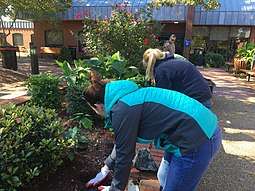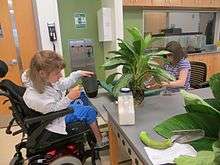Horticultural therapy
Horticultural therapy (also known as social and therapeutic horticulture or STH) is defined by the American Horticultural Therapy Association (AHTA) as the engagement of a person in gardening and plant-based activities, facilitated by a trained therapist, to achieve specific therapeutic treatment goals[1]. Direct contact with plants is believed to guide a person's focus away from stress enhancing their overall quality of life.[2] The AHTA believes that horticultural therapy is an active process which occurs in the context of an established treatment plan.[1] Horticultural therapists are specially educated and trained members of rehabilitation teams (with doctors, psychiatrists, psychologists, occupational therapists and others) who involve the client in all phases of gardening, from propagation to selling products, as a means of bringing about improvement in their life.

Types of Treatment
Goals and types of treatment vary depending on the facility using horticultural therapy. Institutions from schools and nursing homes to prisons utilize horticultural therapy to meet therapeutic needs. Each one of these facilities have different types of horticultural therapy, each with their own individual forms of treatment[3]. Fundamentally horticultural therapy can be divided into three types of programming: Vocational, therapeutic, and social[4].
Vocational Horticultural Therapy
Vocational Horticultural Therapy is intended to teach skill and enhance behaviors that can be used in a job or workplace[4]. People undergoing vocational therapy can learn skills involving greenhouses, vegetable gardening, tree and shrub care , as well as learn about plant production, sales and services[4]. Activities vocational therapy teaches consists of how to repot, water, and move plants within their space. Learning the basic knowledge of their plants root system and the care different plants need is taught at their own pace.[4] Ultimately aimed at employment, vocational horticulture therapy teaches people how to grow and work with plants while also learning the benefits of supporting themselves mentally and financially.

Therapeutic Horticultural Therapy
Therapeutic Horticultural Therapy has its focus on medical and illness recovery[4]. The central belief that therapeutic horticulture therapy revolves around is that being in nature has restorative properties[3]. Therapeutic horticulture might be used to try and improve physical activity, social skills and engagement[4]. Activities encompassed by therapeutic horticulture vary widely, some activities include: repetitive actions such as digging and watering, making observations about plant growth and change, relating plant life cycle to human life, and starting seeds. It has been suggested that things such as new growth on their plants can excite the caretaker, building up their confidence and increasing enthusiasm towards horticultural activities[5]. The impact that therapeutic horticulture has on both mind and body, as well as its ability to be undertaken in small spaces makes therapeutic horticulture an attractive option for smaller facilities.
Social Horticultural Therapy
Social Horticultural Therapy is focused on leisure activity and enhancement of life quality[4]. Unlike therapeutic horticultural therapy, social horticultural therapy is more likely to be activity based[4]. Social Horticulture therapy works to create a community that focuses on plant growth and teaches self-reliance all while providing a support system.
Past Experiments With Horticulture Therapy (Recent 2019)
The National Council for Therapy and Rehabilitation through Horticulture created a journal of 2019 experiments. These experiments tracked the progress of people with certain health conditions using horticulture therapy (HT) to document how it changed their mental and physical health. This journal in which this research is published is called "Journal of therapeutic horticulture" and is a part of the AHTA.
Throughout 2019 there were three experiments tested by (AHTA). The groups tested had a varied range of mental disorders, and the experiments aimed to see how horticultural therapy improved their functioning[6]. Over the course of three months this therapy was mixed in with Schizophrenic patient's schedules while also receiving occupational therapy. Their progress was documented over their course of treatment based upon how their symptoms of depression and anxiety fluctuated, along with their attitude towards life.[6] horticultural therapy was indicated to help reduce their symptoms but did not decrease their feelings of "hopelessness." An experiment later on was given to women with a past of sexual abuse taken over a course of ten weeks. They found involvement with horticulture broadened their "time with nature." This form of therapy was documented as helpful to forming better "relationships" with others and changing their view on life moving forward.[6] The third experiment was provided to veterans and active duty members in order to open their awareness towards mental health. This therapy provided them with professional sources that could help them with the aftermath of being on duty. Those that took part in HT found working with nature and plants to be helpful and distracting.[6]
Education And Job Requirements As A Horticultural Therapist
.jpg)
Education: In order to become a horticultural therapist a bachelor degree in Horticultural Therapy, Human Science, or Plant Science is required. After schooling there are internships that give hands on experience, which needs to be at least 480 hours of work in total.[7]
Requirements
- Working with clients/patients, focusing on their psychological blockages
- Creating an environment in which people can grow plants
- Working with a psychologist and patients together to incorporate multiple perspectives in ways to help
- Teaching the basics of plant growth including watering, potting, fertilizing, etc
- Directing volunteers and other workers
- Providing tasks for each client/patient[8]
History
The use of horticulture to calm the senses dates as far back as 2000 BC in ancient Mesopotamia, and around 500 BC, ancient Persians created gardens to soothe the senses by involving beauty, fragrance, flowing water, and cool temperatures.[4] According to the American Horticultural Therapy Association, Ancient Egyptian physicians prescribed walks around a garden for patients with mental illness;[9] which makes the first sign of the therapeutic process in Alexandria and Ancient Egypt through Renaissance Europe.[10] During the Middle Ages, on the grounds of a monastery hospital, plants were used to express purpose of cheering up melancholy patients. Also, the gardens were used to treat both physical and mental ailments of sickness who visited them.[10] The first modern documentation of horticulture being used as a treatment for mental health purposes was in the 1800s. Dr. Benjamin Rush was the first to suggest that field labor in a farm setting helped attain positive outcomes for clients with mental illness[11]This discovery lead many hospitals in the western world to begin using horticulture as a means to start therapeutically treating patients with mental health and developmental disabilities. In 1817, the Asylum for Persons Deprived of Their Reason, now known as Friends Hospital, constructed an environment with landscaping, paths and a park atmosphere in effort to assist patients in their recovery. In 1879 Friends Hospital built the first greenhouse that was used for therapy[12]. Post World War 1 horticultural therapy was used to help servicemen rehabilitate, in the 1940s garden club members brought garden activities to the servicemen and in 1960 the first published book on horticultural therapy was written[13]. The first degree in horticultural therapy was established in 1972[13].

In 1973 the Council for Therapy and Rehabilitation through Horticulture (NCTRH) was established by a group of horticulture therapy professionals. In 1988, they changed their name to the American Horticulture Therapy Association (AHTA) which they are still called today. AHTA is a non-profit organization with about 25% off their members being professionally registered.[14]
Today, horticultural therapy is practiced in many countries and area in the world, such as in Japan, Korea, Hong Kong,[15] the United Kingdom, Germany, Italy and Sweden. Many universities in these countries have education programs and research in horticultural therapy. Special laboratories have also been built, such as Alnarp Rehabilitation Garden at the Swedish University of Agricultural Sciences campus area in Alnarp.

Horticultural therapy in fiction
The beneficial influence of horticultural therapy on human health has been presented in fiction, for example:
- "Five peas from a pod" – fairy tale by Hans Christian Andersen (probably mid-19th century)
- The Secret Garden – novel by Frances Hodgson Burnett (1911)
See also
References
- "American Horticultural Therapy Association Definitions and Positions" (PDF). Archived from the original (PDF) on 2013-09-08.
- Lin, Lin, Li (2014). "Planting Hope in Loss and Grief: Self- Care Applications of Horticultural Therapy for Grief Caregivers in Taiwan". Death Studies. 38 (9): 603–611. doi:10.1080/07481187.2013.820231. PMID 24588807.CS1 maint: multiple names: authors list (link)
- "What is Social Therapeutic Horticulture?". Thrive. Retrieved 2019-11-17.
- Simson, Sharon Pastor, Hrsg.. (2007). Horticulture as therapy : principles and practice. Food Products Press. ISBN 978-1-56022-279-8. OCLC 916655353.CS1 maint: multiple names: authors list (link)
- Detweiler, Mark B.; Sharma, Taral; Detweiler, Jonna G.; Murphy, Pamela F.; Lane, Sandra; Carman, Jack; Chudhary, Amara S.; Halling, Mary H.; Kim, Kye Y. (June 2012). "What Is the Evidence to Support the Use of Therapeutic Gardens for the Elderly?". Psychiatry Investigation. 9 (2): 100–110. doi:10.4306/pi.2012.9.2.100. ISSN 1738-3684. PMC 3372556. PMID 22707959.
- "Journal of Therapeutic Horticulture 29.2 - 2019". www.ahta.org. Retrieved 2020-04-19.
- "Education for Horticultural Therapists". www.ahta.org. Retrieved 2019-11-17.
- "Horticultural therapist | Explore careers". nationalcareers.service.gov.uk. Retrieved 2019-11-17.
- admin (2019-02-18). "Discover Whether Horticultural Therapy Can Finally End The Torture of Being a Mental Illness Victim?". Olmec Agro-Tech. Retrieved 2019-03-19.
- "The Role Application of Horticultural Therapy With Institutionalized Older People" (PDF).
- Rush, Benjamin (1830). "Medical inquiries and observations upon the diseases of the mind, 4th ed". doi:10.1037/11843-000. Cite journal requires
|journal=(help) - UHSAdmin (2019-02-18). "History of Friends Hospital | Psychiatric Hospital | Philadelphia, PA". Friends Hospital | Philadelphia, PA. Retrieved 2020-04-19.
- "American Horticultural Therapy Association". 2007.
- American Horticultural Therapy Association https://www.ahta.org/mission-vision. Retrieved 4 July 2019. Missing or empty
|title=(help) - Hong Kong Association of Therapeutic Horticulture http://www.hkath.org/en/milestone/. Retrieved 4 July 2019. Missing or empty
|title=(help)